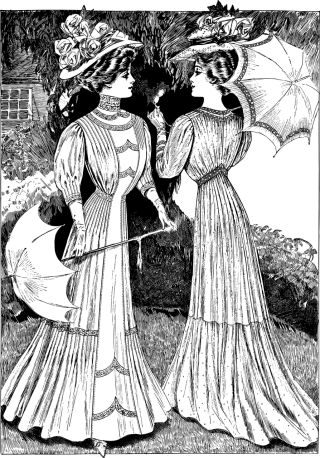Bias
Why Do We Diss Women’s Speech?
The 3 reasons women’s voices are subject to negative stereotypes.
Posted April 9, 2023 Reviewed by Tyler Woods
Key points
- Women's voices were historically relegated to the domestic sphere.
- Young women tend to be more creative linguistically.
- Workplace norms are often based on those more typical in men's speech.
Like, literally, you know, so, um, totally: These are just a few of the features that often get associated with women’s speech, and not in a good way. Instead, most of the time, young women’s voices are not lauded but lamented. Considering that women have long been one of the most powerful forces behind language change, why do we still have such negative stereotypes about the way they talk?
Acting like a lady
The first reason? Quite simply, history. Women have, until very recently, been valued as silent partners, rather than verbal ones, particularly in spheres traditionally considered men’s areas of expertise. In antiquity, women were not welcome in public, political, or legal forums, forced instead to lobby their husbands or male relatives to speak on their behalf on topics that fell outside the domestic.

Likewise, in the late Medieval period, women who spoke out in ways considered disruptive in public were accused of being “scolds” and charged with what was referred to as a sin of the tongue. Though men could be accused of such crimes as well, historian Sandra Bardsley found that women were disproportionately charged, making up well over eighty percent of cases.
By the Victorian period, women’s voices were not subject to criminal control, but rather to intense social expectation. Well-bred and stylish women were those who knew how to be charming and proper in speech, fashion, and manners. Still today, little girls are cautioned to “act like a lady,” echoing these earlier ideas of feminine virtue.
As a result of these historically based views of women’s talk, we are more attuned to the amount and the type of talk that women contribute. Women’s speech outside the domestic sphere is often more noticed than men’s, leading to the sense that women talk too much or use flowery and weak language. When girls use obscenity or non-standard speech, they are also more likely to be noticed for acting outside the norms of linguistic behavior compared to boys.
Linguistic fashionistas
The second reason we tend to diss women’s speech more is because women tend to pick up new forms and features before anyone else does. What’s new—and different from what we think of as ‘normal’—is a beacon for negative notice, at least until the rest of the population catches up and it just becomes something everyone says.
This innovative tendency of women has brought to the fore many features we find rapidly expanding in our speech today such as quotative-like use (as in, “I was like…”), the scratchy low pitch of vocal fry, and the rise of new adverbial intensifiers like so or totally (i.e., "so totally happy").
Though young men often play catch up within a decade or two, women’s linguistic creativity stands out and they take the heat for these features because, as leaders of a new trend, it attracts more attention to their talk. But so many forms that we treat as well-established and completely natural today, for instance, saying you instead of ye, using third person verbal forms like does instead of doth, and saying have to instead of must were initially changes led by women. It just takes a bit of time for new speech habits to move from being novel to being the norm.
Job talk
The third reason we are more likely to be hesitant to embrace the features that populate women’s talk is because workplace culture has long been the domain of men in leadership and managerial roles. As a result, aspects associated with women’s language, such as having a higher voice pitch or the new features they’ve introduced into language are heard as comparatively weaker or less certain. In large part, this happens because the speech of those who have traditionally been in the ranks of the organizationally powerful have a different linguistic style.
For instance, women are more often users of discourse markers such as like or so or well as part of their linguistic style. Such features are very useful in attending to conversational structure, recognizing what has previously been said, and linking it to what is upcoming. And, in fact, some research has found that discourse markers are often used by more conscientious speakers. But because women use more of them, and discourse markers are not well perceived in professional contexts where male speech patterns predominate, this can unwittingly affect how employers and managers view women’s contributions.
Up and comers
A lot of our linguistic judgment is directed toward women—which is unfortunate since this has much to do with the historical absence of women’s speech in public and professional environments, and the fact that women are more innovative linguistically so their use of features such as so, like, and vocal fry draws notice. Ironically, this prescience of women for what’s up and coming has moved language forward over time rather than held it back, despite the negative press that their choices often attract.
As far back as 1905, when studying a Swiss-French dialect in Switzerland, linguist Louis Gauchat found women most prominently leading the charge in changes there, leaving him to conclude that “women welcome every linguistic novelty with open arms.” Perhaps the time has come for all of us to open our arms a little wider to the benefits, rather than the deficits, that are to be found in women’s speech.
References
Bardsley, S. (2006). Venomous Tongues: Speech and Gender in Late Medieval England. University of Pennsylvania Press.
Laserna, C. M., Seih, Y.-T., & Pennebaker, J. W. (2014). Um . . . Who Like Says You Know: Filler Word Use as a Function of Age, Gender, and Personality. Journal of Language and Social Psychology, 33(3), 328–338.
Nevalainen, T. (2002). Language and Woman’s Place in Earlier English. Journal of English Linguistics, 30(2), 181–199.




